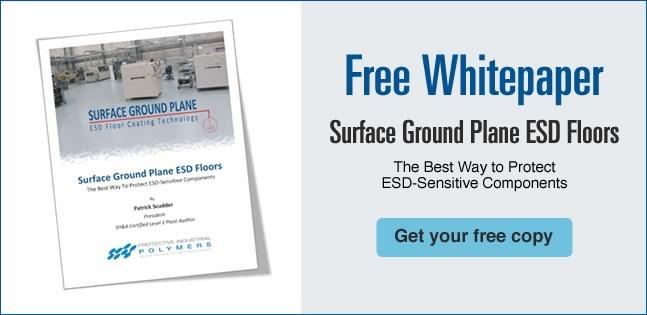In the past, ESD-control polymer floor coatings were only available in a limited variety of solid color options. This was due to the specialized ESD pigment used to make the polymer electrically active. Because this pigment was inherently dark, brighter colors were not able to be achieved in esd floor design ideas. End-users were stuck with very few color and decorative options. ESD flooring products like carpet and ESD tile filled the need for aesthetically-pleasing ESD flooring options.
Although ESD carpet, laminates and tiles provide a myriad of decorative and color options, they still rely on older “facilitated pathway” technology to exhibit ESD floor performance characteristics. Here, the flooring medium must be installed over conductive ground plane adhesives or primers. Generated static charges must contact a conductive point, or points, on the surface (facilitated pathways) to be transferred through the surface to the underlying ground plane where it is then carried away to ground. The use of a facilitated ESD flooring system is less efficient but common in the market.
As ESD floor performance guidelines continue to become more and more stringent, with lower ESD tolerance thresholds, the need for a combination of ESD floor performance and aesthetics becomes paramount.
Protective Industrial Polymer’s unique Protect 200 ESD UR urethane ESD-control coating has revolutionized the ESD-control polymer floor coating market. PIP’s proprietary particulate ESD technology has allowed them to design a coating that not only is available in a vast array of bright, vivid colors, but one that also can be used as a transparent topcoat for decorative quartz and flake floors. It’s even possible to coat existing ESD tile floors, eliminating the need to perform continuous, expensive stripping and ESD waxing maintenance…all while providing BVG readings below 15 volts with conductive footwear. This is due to PIP’s ‘Surface Ground Plane’ technology.
A ‘Surface Ground Plane’ coating system provides the ultimate means of direct contact of the ESD floor to electrical ground. This is the most efficient transfer method simply because the entire topcoating acts as its own ground plane. Here, a static charge immediately flows to the electrical ground without contacting individual points and travelling through conductive materials or facilitators.
End-users can now achieve the best of both worlds – the most consistent and reliable ESD-control performance, combined with a vast array of color and decorative options…plus, all the benefits of polymer flooring, including:
- No waxing required
- Excellent Impact & abrasion resistance
- Excellent chemical resistance
- Superior cleanability
- Lower life cycle costs
Want to learn more about Surface Ground Plane ESD flooring systems? Download our latest whitepaper entitled “Surface Ground Plane ESD Floors – The Best Way to Protect ESD-Sensitive Components”

- A Faster Cure for Flooring Needs: Polyaspartics in Action - April 8, 2025
- The Case for Epoxy Mortar in Manufacturing - April 8, 2025
- Epoxy Mortar Flooring: Built for Heavy-Duty Performance - March 29, 2025

